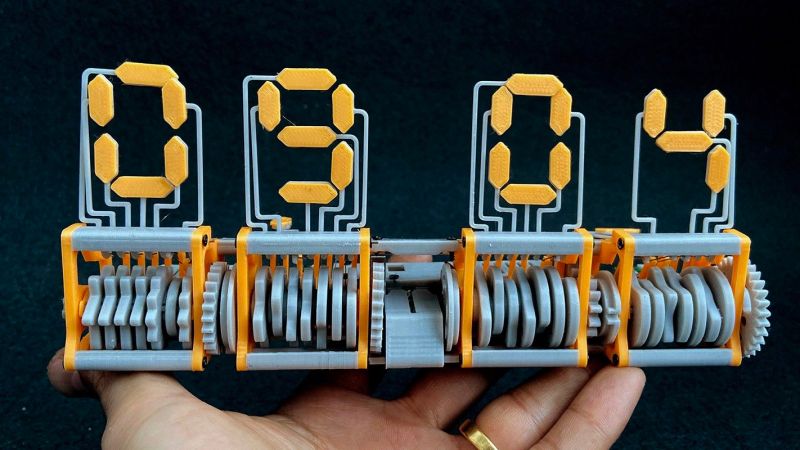Clocks are such mundane objects that it’s sometimes hard for them to grab your attention. They’re there when you need them, but they don’t exactly invite you to watch them work. Unless, of course, you build something like this mechanical flip-segment clock with a captivating exposed mechanism
“Eptaora” is the name of this clock, according to its inventor [ekaggrat singh kalsi]. The goal here was to make a mechanical flip-segment display as small as possible, which meant starting with the smallest possible printable screw hole and scaling the design up from there. Each segment is controlled by a multi-lobed cam which bears on a spring-loaded cam follower. When the cam rotates against the follower, a segment is flipped up from the horizontal rest position to the vertical display position. A carryover mechanism connects two adjacent displays so that each pair of digits can be powered by a single stepper, and the finished clock is quite small — a little bit larger than the palm of a hand. The operation seems quite smooth, too, which is always a bonus with clocks such as these. Check out the mesmerizing mechanism in the video below.
We’d have sworn we covered a similar clock before — indeed [ekaggrat] says the inspiration for this clock came from one with a similar mechanism — but we couldn’t find it in the back catalog. Oh sure, there are flip-up digital clocks and all manner of mechanical seven-segment displays, but this one seems to be quite unique, and very pleasing.

















It looks so smooth and clean in the video, makes me wonder if it is actually a rendering.
I would say no: the alignment unprecision is pointing to it being real.
Good job!
it is very hard to render it .. much easier to make it real. I actually made many prototypes before i even managed to render it for the cam explanation video!
In that case, thumbs up! Making a film look this clean without it being a render is quite the feat in it’s own right.
Very impressive work
Very nice design. Like it a lot!
So cool!
Oh come on ;-) This is really not so hard to render…
I had one , a SONY, back in the late ’60s. Very cool.
This is amazing! What a fabulous use of a unique cam shafts. Some tiny bearings might be in order though as friction will quickly take a toll on it.
Maybe . but that is not the point of failure i am afraid of. What might fail is the tip of the follower wearing out over time . Lets see. I have it running now. So time will tell
“So time will tell”
I see what you did there!
B^)
So ekaggrat, where can i buy one? And how much will it cost?
Same here.
Agreed. You should sell these.
Would look better with the support “wires” painted flat black. With the right lighting the effect would look like magic, but for detail of the build the whiteness shows how it works. Magic 8 ball effect.
they are too small to be even seen. Phone photography just makes things look much bigger than what they are.
I would put what inside a dark enclosure with a glass, blacklight LEDs and UV reactive paint on the digits so they stand out and everything else remains almost invisible.
I’m wondering if there’s a way to even limit light coming in through the glass while letting the digit light out so that the mechanism is even less visible from external light…
But the mechanics are what makes this cool – they need to be seen!
UV Paint o Fluor Acrylic and UV LED or combinations of LEDS maybe
Nice. I’ve been kicking around a very similar idea, but at a much larger scale, like 2 foot high digits, for an outdoor application.
humm . it would be fun to make a bigger one in steel . scare the daylights out of people when the digits move. 6 feet tall maybe
Moving a 6ft steel segment would need a beefy motor, and the inertia would mean you would need brakes unless you want your display to disassemble itself in a few minutes.
Thanks for your links to my projects in the last paragraph. However, the most similar project is as follows.
http://fablabsendai-flat.com/2019/11/04/mechanical7seg_jp/
https://www.youtube.com/watch?v=tSkKMkYYUJM
thank you for introducing my work
You could enhance it by somehow making the segments brighter or more distinct when they reach their final position I think.
Perhaps by making them contact something that guides light to them? Either mechanically or electrical would be feasible.
As it is now I think it’s a bit confusing when it changes fast, like the right-most digits do.
What an amazing design.
Super cool, perhaps worth an experiment is to delay the drop down of the segments just a tiny bit, so it visually happens more at the same time when a segment moves in place. With the intention the make the time a “nonsense” value is shown.
what I meant to say is “to make the time a “nonsense” value is shown as small as possible”
Super cool. I wonder how it would work to come up with a mini solenoid arrangement, one per segment, so you’d be able to spell anything. A “toggle over center” design would require no power for steady state.
I want to buy one , where and how ? Awesome job
There’s actually an entirely mechanical flip segment wristwatch. https://www.ablogtowatch.com/de-grisogono-meccanico-dg-watch-hands-on/
If we can’t buy this, could we have the printer files?
Would love to have one of these on my desk.
Looks like someone is trying to launch a kickstarter using this design.
https://www.kickstarter.com/projects/1450721754/rantogean-electromechanical-cam-clock-that-hears-the-time?ref=discovery
This is amazing!!!
Love it, thanks for sharing!
So simple and complex at the same time..